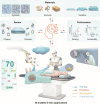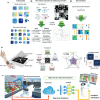Toward an AI Era: Advances in Electronic Skins
- PMID: 39198214
- PMCID: PMC11397144
- DOI: 10.1021/acs.chemrev.4c00049
Toward an AI Era: Advances in Electronic Skins
Abstract
Electronic skins (e-skins) have seen intense research and rapid development in the past two decades. To mimic the capabilities of human skin, a multitude of flexible/stretchable sensors that detect physiological and environmental signals have been designed and integrated into functional systems. Recently, researchers have increasingly deployed machine learning and other artificial intelligence (AI) technologies to mimic the human neural system for the processing and analysis of sensory data collected by e-skins. Integrating AI has the potential to enable advanced applications in robotics, healthcare, and human-machine interfaces but also presents challenges such as data diversity and AI model robustness. In this review, we first summarize the functions and features of e-skins, followed by feature extraction of sensory data and different AI models. Next, we discuss the utilization of AI in the design of e-skin sensors and address the key topic of AI implementation in data processing and analysis of e-skins to accomplish a range of different tasks. Subsequently, we explore hardware-layer in-skin intelligence before concluding with an analysis of the challenges and opportunities in the various aspects of AI-enabled e-skins.
Conflict of interest statement
The authors declare no competing financial interest.
Figures




















References
Publication types
MeSH terms
LinkOut - more resources
Full Text Sources
Miscellaneous

